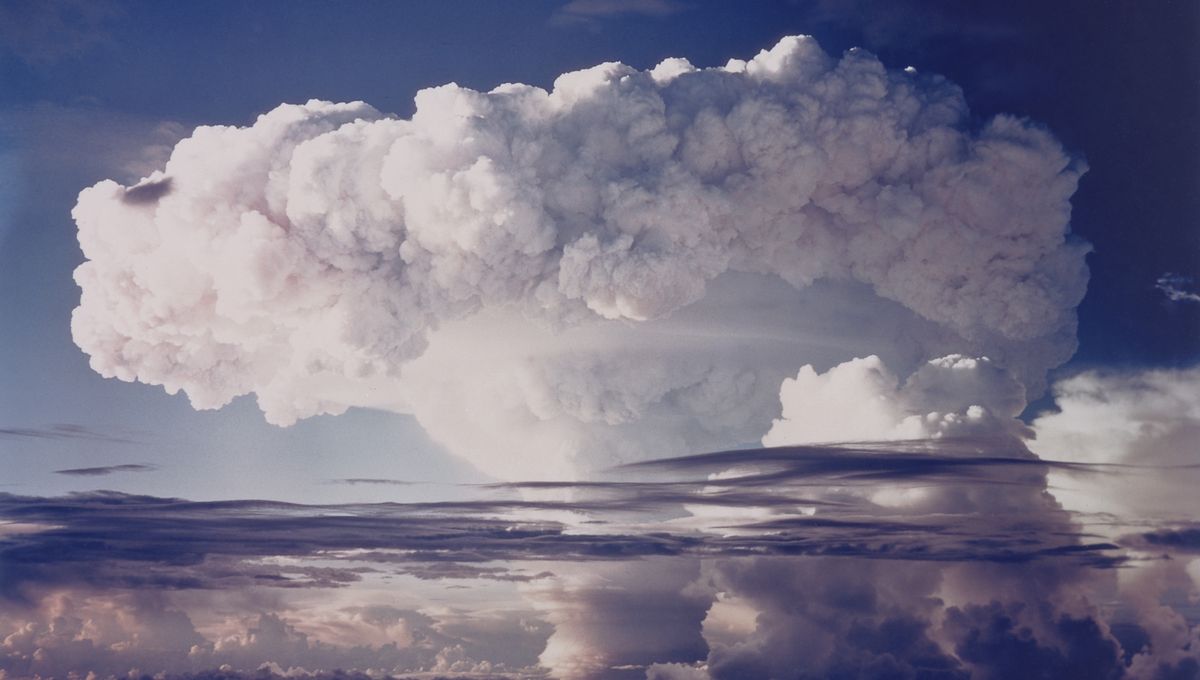
Now that the highly anticipated Oppenheimer movie has been released at the cinemas, audiences are encountering the gripping scientific and ethical dilemmas posed by the invention of the atomic bomb. However, lurking in the background of this narrative was something that made even the strongest supporters of a nuclear deterrent pause for thought – the hydrogen bomb. But what is this monstrous weapon, and how is it different from the nuclear weapons that were dropped on Hiroshima and Nagasaki in August 1945?
What is a hydrogen bomb?
The nuclear weapons dropped on Hiroshima and Nagasaki were responsible for killing between 129,000 and 226,000 people, most of whom were civilians. The explosions were so devastating that Japan was forced to surrender (though there is evidence that they were preparing to do so before the bombings), which brought the Second World War to an end.
These weapons were like nothing the world had ever seen and their destructive power was equivalent to 15,000 tons of TNT at Hiroshima and 25,000 tons of TNT at Nagasaki. They were unparalleled at the time, but soon after their invention attention turned to the next big thing – the hydrogen bomb. This goliath among weapons was so intimidating, that many of the scientists who worked on the creation of the original atomic bombs in the Manhattan Project opposed its creation.
But why was this thing so terrifying? Well, a hydrogen bomb, or thermonuclear weapon as it is otherwise called, has the potential to be 1,000 times more powerful than the weapons dropped on Hiroshima and Nagasaki. Such a scale of magnitude is difficult to imagine when dealing with such huge potential, but every aspect of its explosion– from its initial blast to the accompanying shockwave, heat, and radiation – would wipe out entire cities and cause devastation within five or 10 miles of its destination (for perspective, the bomb dropped on Nagasaki killed everyone within a one-mile radius).
The sheer power of this type of weapon was so unthinkable that Enrico Fermi and Isidor Rabi, two physicists who worked on the Manhattan Project, wrote an addendum to the General Advisory Committee’s report on the hydrogen bomb in 1949, which stated:
“A decision on the proposal that an all-out effort be undertaken for the development of the [hydrogen bomb] cannot in our opinion be separated from considerations of broad national policy […] Necessarily such a weapon goes far beyond any military objective and enters the range of very great natural catastrophes. By its very nature it cannot be confined to a military objective but becomes a weapon which in practical effect is almost one of genocide.”
They added, “It is clear that the use of such a weapon cannot be justified on any ethical ground which gives a human being a certain individuality and dignity even if he happens to be a resident of an enemy country.”
How does it work?
A hydrogen bomb is basically an advanced atomic bomb, as you actually need the latter to make the former. Atomic bombs like those used in Japan in 1945 rely on fission reactions to liberate massive amounts of energy from relatively small amounts of either uranium or plutonium. In these weapons, the explosion caused by this sudden reaction is sufficient, but a hydrogen bomb uses this type of explosion to trigger a subsequent fusion reaction. In this sense, a hydrogen bomb is basically a two-stage weapon.
Stage 1: The weapon is arranged as an implosion device, which means that the fissionable material at its core is rapidly compressed to cause the nuclear reaction. The device is typically spherical in shape, and has an outer layer made up of conventional explosives. When they are detonated, heat and energy is directed inwards and the core fissile material shrinks in on itself. This increased density releases free neutrons and results in a chain reaction that causes the explosion.
Stage 2: When the primary fission device triggers, the explosion releases high-energy gamma and X-rays, which are channeled and reflected onto a fusion device containing lithium deuteride. The device’s containment shell is also filled with polystyrene foam, which turns into plasma after the first explosion. This plasma then starts to compress a cylindrical casing that contains a uranium tamper designed to absorb some of the X-rays to prevent an early detonation. Then a sparkplug-like component made of fissionable materials is compressed to cause more fission reactions and an outward explosion. The heat and pressure from this explosion causes the lithium deuteride to release tritium, which then fuses with the deuterium to create helium (like a small Sun) and even more neutrons.
The released neutrons then cause more fission reactions, which exert more pressure on the lithium deuteride, which results in additional fusion reactions. The continued cycle of these reactions – fission and fusion – then causes a massive explosion.
The US first tested the power of a hydrogen bomb on November 1, 1952 during Operation Ivy. The weapon was detonated on the small Pacific island of Elugelab at Enewetak Atoll in the Marshall Islands. The explosion was equivalent to 10 megatons of TNT, about 1,000 times more powerful than the bomb dropped on Hiroshima.
Although such a weapon has never been used against an enemy target, the threat they pose is immense. The dread they inspire should be even higher considering how many of them there are in the world today.
Source Link: What Is An H Bomb?